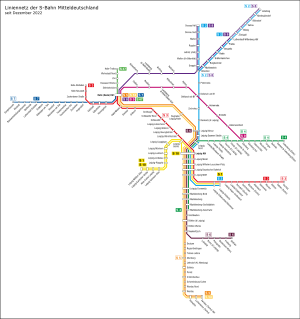
Back S-Bahn Mitteldeutschland German S-Bahn Mitteldeutschland Esperanto S-Bahn Mitteldeutschland Spanish اس-بان میتهدویچلند Persian S-Bahn d'Allemagne centrale French S-Bahn Mitteldeutschland Hungarian S-Bahn della Germania Centrale Italian 中部ドイツSバーン Japanese 중부독일 S반 Korean S-Bahn de la Germania Central LMO
| Mitteldeutschland S-Bahn | |||
|---|---|---|---|
 | |||
 Former trains of S-Bahn Mitteldeutschland and Regionalbahn at Leipzig City Tunnel (Leipzig Markt station) | |||
 | |||
| Overview | |||
| Area served | Central Germany | ||
| Transit type | Rapid Transit, Regional rail | ||
| Number of lines | 10 | ||
| Number of stations | 145 | ||
| Daily ridership | 90,000[1] | ||
| Website | www | ||
| Operation | |||
| Began operation | 15 December 2013 | ||
| Operator(s) | DB Regio Südost | ||
| Number of vehicles | 80 Bombardier Talent 2 | ||
| Technical | |||
| System length | 802 km (498 mi) | ||
| Track gauge | 1,435 mm (4 ft 8+1⁄2 in) standard gauge | ||
| Electrification | 15 kV 16+2⁄3 Hz AC catenary | ||
| Top speed | 160 km/h (99 mph) | ||
| |||
Mitteldeutschland S-Bahn (German: S-Bahn Mitteldeutschland), lit. 'Middle Germany S-Bahn', represents an enlargement of the previous Leipzig-Halle S-Bahn. It is an electric rail public transit system operating in the metropolitan area of Leipzig-Halle, Germany. This S-Bahn (German abbreviation for Stadtschnellbahn - lit. 'urban rapid [rail]road') network developed from two separate S-Bahn networks of Halle (Saale) and Leipzig, which were established separately in 1969 and then linked in 2004. With the opening of the Leipzig City Tunnel on 15 December 2013 as a new artery, the network was extended for the first time to the federal states of Thuringia and Brandenburg. With a system length of 802 km (498 mi), it is the largest S-Bahn network in Germany, displacing the long-time title holder Rhine-Ruhr S-Bahn from that position. The locomotive-hauled double-decker trains partly dating back to the DDR-era have been largely replaced by electric multiple unit Bombardier Talent 2 trains, but some older trains are still used during rush hour.
It is operated by DB Regio Südost, Verkehrsbetrieb Mitteldeutschland mainly on behalf of Zweckverband für den Nahverkehrsraum Leipzig (ZVNL) and Nahverkehrsservicegesellschaft Sachsen-Anhalt GmbH (nasa), but also another four public transport authorities in Saxony, Thuringia (Nahverkehrsservicegesellschaft Thüringen) and Brandenburg (Verkehrsverbund Berlin-Brandenburg).
- ^ "Mitteldeutsches S-Bahn-Netz soll wachsen". Leipziger Volkszeitung (in German). 13 December 2018. Retrieved 7 November 2019.
